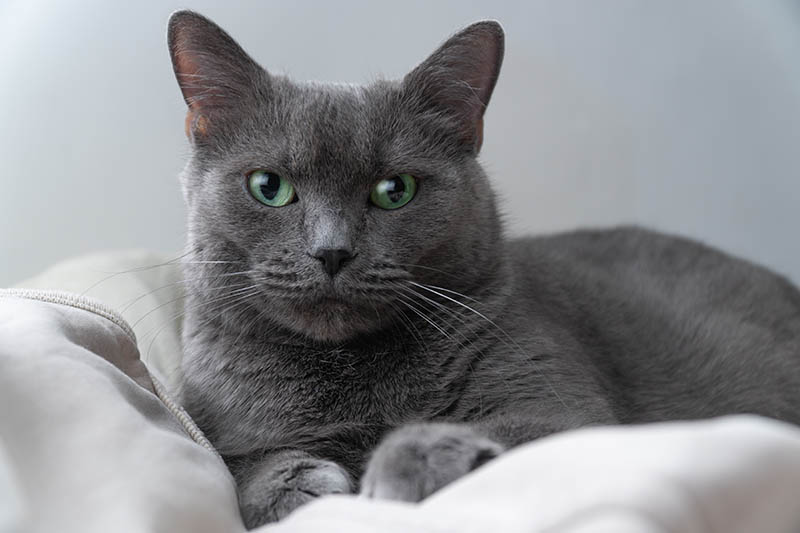12 Surprising Russian Blue Cat Facts: Origins, Traits & Behaviors
By Adam Mann
Updated on

Russian Blues are strikingly beautiful cats, and when you combine this with their sweet and loving nature, it’s no wonder they’re so popular. But while they’re an extremely loved cat breed, the Russian Blue also has some interesting facts for you to check out. We’ve highlighted 12 of those facts below.
The 12 Russian Blue Cat Facts:
1. Russian Blue Cats Have a Slight Smile
If you’ve ever seen a picture of the Mona Lisa, you already know the type of smile a Russian Blue has. It’s a signature feature you can expect with every Russian Blue, especially when they get a bit older. It doesn’t always mean they’re happy since; this is just how their lips look on their face, but it does make them look that much cuter!

2. All Russian Blue Cats Are Born With Yellow Eyes
While a Russian Blue might have different colored eyes when they’re older, when they’re born, every Russian Blue has yellow eyes. Eventually, these eyes usually turn to a brilliant emerald color.
3. They’re Great Hunters
When you take a look at the Russian Blue’s origins as a hunting cat on boats, it’s no surprise that these cats still maintain a high prey drive. They want to be on the prowl looking for things, and if they don’t have prey to go after, you’ll need to find other ways to stimulate them.
Laser pointers and other toys can go a long way in keeping them stimulated, and it’s pretty much a necessity if they’re an indoor cat.

4. They Are Very Loving
While Russian Blue cats have strong hunting instincts, that doesn’t detract from their loving nature. They enjoy entire families, but they definitely bond with one person more than anyone else. Just keep in mind that while they’re loving with people and even dogs, they’re not great to have around other small pets, like lizards or birds.
5. Russian Blues Have Long Lifespans
The Russian Blue has a long lifespan, even compared to most other cat breeds. The average Russian Blue will live somewhere between 15 and 20 years, but some of these cats have even lived 25 years! That means if you’re getting one of these cats, you better be ready to care for them for the long haul.

6. The Breed Almost Went Extinct After WWII
During World War II, the breeding of cats and other pets went to the wayside, and because of this, the Russian Blue almost didn’t make it back after the war. However, due to a few dedicated breeders in Europe, the Russian Blue survived.
7. They Are Very Smart
Everyone knows that cats are pretty smart pets, but the Russian Blue stands out even among other smart cat breeds. They love to learn new things, and you can train them to complete various tasks, but just keep in mind they’re very reward-based, so keep the treats flowing when you’re trying to train them.

8. They Are Very Vocal
If you want a quiet cat breed, the Russian Blue is not the way to go. They have no problem meowing at you to get your attention, and they won’t give you some quiet meows. They’ll let you know when they want food, and they can also be loud with their vocalizations when you’re playing with them.
9. Russian Blue Cats Can Be Shy
While the Russian Blue is a loving and adorable cat, sometimes it can take them a while to warm up to people. If you’re trying to introduce them to your friends, they might prefer to hide away for a bit first, and when you bring them home for the first time, expect that they won’t open up to you immediately.

10. They Only Shed a Little
While the Russian Blue is not a hypoallergenic cat, if you only suffer cat allergies from heavy shedders, you might not have an issue with a Russian Blue. Not only that but since they don’t shed too much, you don’t have to spend quite as much time brushing them out or cleaning up their hairs as you do with other cat breeds.
11. Russian Sailors First Brought Them on Ships
Likely, the first people who domesticated the Russian Blue were sailors who wanted these cats on their ships to help catch mice and other rodents onboard. They were working cats through and through, but before them, it’s likely that Russians hunted these cats for their soft coats.

12. They Officially Became a Breed in 1912
The first Russian Blues made it to the United States around 1912, and it was also around this time that they gained formal recognition. This set stricter breed standards, but it was far from the first time someone owned a Russian Blue!
Conclusion
Whether you just wanted to learn a little more about the Russian Blue or you’re thinking about bringing one home yourself, now that you know a little more about these beautiful cats, you can appreciate them even more. They’re gorgeous and loving felines that make great companions, so it’s no wonder so many people in the world want and adore them!
Featured Image Credit: Review News, Shutterstock












